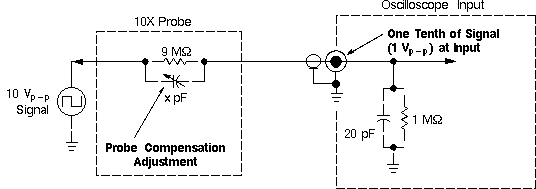Probes
Now you are ready to connect a probe to your oscilloscope. It is important to use a probe designed to work with your oscilloscope. A probe is more than a cable with a clip-on tip. It is a high-quality connector, carefully designed not to pick up stray radio and power line noise.
Probes are designed not to influence the behavior of the circuit you are testing. However, no measurement device can act as a perfectly invisible observer. The unintentional interaction of the probe and oscilloscope with the circuit being tested is called circuit loading. To minimize circuit loading, you will probably use a 10X attenuator (passive) probe.
Your oscilloscope probably arrived with a passive probe as a standard accessory. Passive probes provide you with an excellent tool for general-purpose testing and troubleshooting. For more specific measurements or tests, many other types of probes exist. Two examples are active and current probes.
Descriptions of these probes follow, with more emphasis given to the passive probe since this is the probe type that allows you the most flexibility of use.
Using Passive Probes
Most passive probes have some degree of attenuation factor, such as 10X, 100X, and so on. By convention, attenuation factors, such as for the 10X attenuator probe, have the X after the factor. In contrast, magnification factors like X10 have the X first.
The 10X (read as "ten times") attenuator probe minimizes circuit loading and is an excellent general-purpose passive probe. Circuit loading becomes more pronounced at higher frequencies, so be sure to use this type of probe when measuring signals above 5 kHz. The 10X attenuator probe improves the accuracy of your measurements, but it also reduces the amplitude of the signal seen on the screen by a factor of 10.
Because it attenuates the signal, the 10X attenuator probe makes it difficult to look at signals less than 10 millivolts. The 1X probe is similar to the 10X attenuator probe but lacks the attenuation circuitry. Without this circuitry, more interference is introduced to the circuit being tested. Use the 10X attenuator probe as your standard probe, but keep the 1X probe handy for measuring weak signals. Some probes have a convenient feature for switching between 1X and 10X attenuation at the probe tip. If your probe has this feature, make sure you are using the correct setting before taking measurements.
Many oscilloscopes can detect whether you are using a 1X or 10X probe and adjust their screen readouts accordingly. However with some oscilloscopes, you must set the type of probe you are using or read from the proper 1X or 10X marking on the volts/div control.
The 10X attenuator probe works by balancing the probe's electrical properties against the oscilloscope's electrical properties. Before using a 10X attenuator probe you need to adjust this balance for your particular oscilloscope. This adjustment is called compensating the probe and is further described in the next section. Following Figure shows a simple diagram of the internal workings of a probe, its adjustment, and the input of an oscilloscope.

Typical Probe/Oscilloscope 10-to-1 Divider Network
Following Figure shows a typical passive probe and some accessories to use with the probe.

A Typical Passive Probe with Accessories
Using Active Probes
Active probes provide their own amplification or perform some other type of operation to process the signal before applying it to the oscilloscope. These types of probes can solve problems such as circuit loading or perform tests on signals, sending the results to the oscilloscope. Active probes require a power source for their operation.
Using Current Probes
Current probes enable you to directly observe and measure current waveforms. They are available for measuring both AC and DC current. Current probes use jaws that clip around the wire carrying the current. This makes them unique since they are not connected in series with the circuit; they, therefore, cause little or no interference in the circuit.
Where to Clip the Ground Clip
Measuring a signal requires two connections: the probe tip connection and a
ground connection. Probes come with an alligator-clip attachment for grounding
the probe to the circuit under test. In practice, you clip the grounding clip to
a known ground in the circuit, such as the metal chassis of a stereo you are
repairing, and touch the probe tip to a test point in the circuit. |